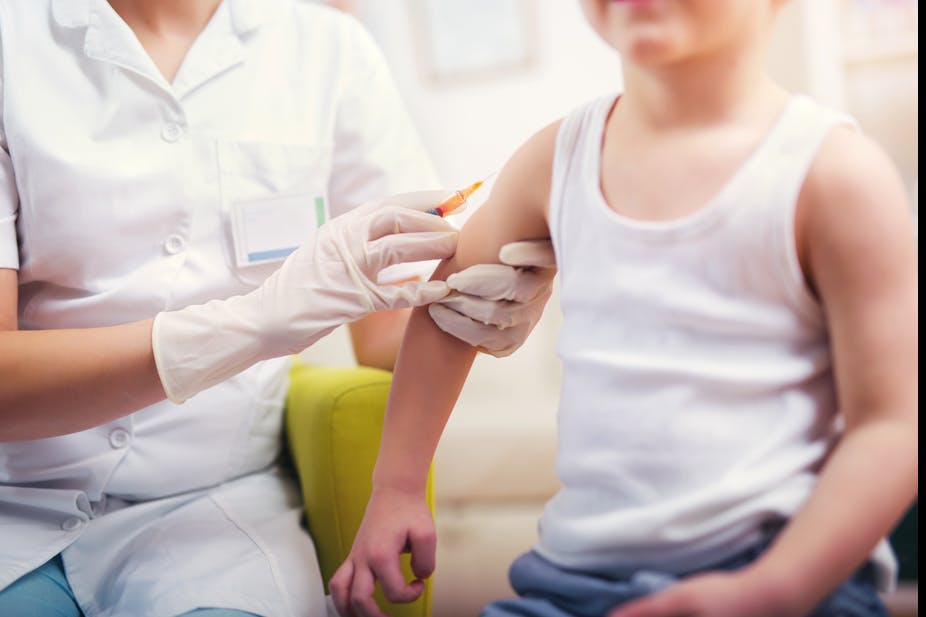Diphtheria is a respiratory disease that was a leading cause of death in children worldwide in the early 20th Century. Thanks to a successful vaccine introduced during the 1940s and 50s, diphtheria is a disease of the past for many people – though it still remains a threat in some parts of the world, including in south Asia and Africa.
Our team of researchers wanted to determine how the disease has changed over the past century to understand what sort of threat it carries today. We found numerous genetic variations in the bacteria that causes diphtheria, alongside a build up of antibiotic resistance. Both of these changes could pose major challenges for future treatment and control.
Diphtheria is caused by the bacterium Corynebacterium diphtheriae, and is spread through droplets in the air. It causes a white-grey build-up in the back of the throat, releasing a toxin that kills the cells in your body. This leads to fever, swollen glands, difficulty breathing, and death within days if left untreated. Symptoms can also be very similar to flu initially, making it difficult to diagnose in areas where it is not common.
While the vaccine offers high levels of protection against the diphtheria toxin, those who haven’t been vaccinated and catch the disease require antitoxin treatment and antibiotics. Despite this, not only are fewer doses of antitoxin being produced worldwide, reports are also beginning to suggest some C. diphtheriae strains are becoming resistant to antibiotics.
Antibiotic resistance happens when bacteria acquire the ability to destroy or avoid the effects of an antibiotic, often thanks to genetic changes. Over-prescribing antibiotics is one cause of resistance. Resistance can be spread from one bacterium to another, and even between different bacterial species.
Knowing how C. diphtheriae has changed over time globally will allow researchers to know whether the vaccine and treatments remain effective, and understand if antibiotic resistance is increasing.
Tracking variants
Cases of diphtheria dropped significantly across the world after the vaccine was developed, and the diseaes had been all but eliminated where vaccine coverage had been high. Spikes have occurred though – such as in the mid-1990s when the Soviet Union dissolved, due to large gaps in vaccine schedules and healthcare systems.
But case numbers are now increasing significantly again globally. The highest number of cases since 1996 were reported in 2019 – 22,986 globally. This increase was driven by a number of major outbreaks, including the ongoing crisis in Yemen.
To understand how diphtheria has changed, we set out to analyse the bacteria’s genome (its DNA and genes). Our team collected 502 separate genomes from over 122 years and 16 countries. A computer analysis then helped us create a “family tree” of C. diphtheriae. This allowed us to not only see how one bacterium relates to another, but to get a global picture of the species and see how certain variants had evolved or changed, and if some are potentially becoming deadlier than others.

We found that there are multiple large groups of specific C. diphtheriae variants circulating within regions across the world that are distantly related – like cousins, but tens or hundreds of times removed. Some of these variant groups have remained relatively unchanged over large periods of time – three decades, in some cases – re-emerging sporadically, with few or no changes to their structures or genomes.
We determined that the toxin upon which the vaccine and antitoxin is based is only one of 18 C. diphtheriae variants we found. Six of these variants carried mutations that impact the toxin’s shape, which could be changing how it interacts with your body’s cells. Future research is needed to determine the real effect of these changes, and soon.
Additionally, bacteria that do not have the toxin but still cause disease have been found more often in recent years, and typically in high-income countries where vaccine coverage is high. This suggests the bacterium may be adapting to the vaccine – in this case by causing disease in a different way than with the toxin.
Most significant is that antibiotic resistance is present in large amounts of the bacteria responsible for more recent cases, with those from the 2010s having on average almost two resistance genes per genome. Crucially, most of the resistance is not for drugs used to treat diphtheria. But it demonstrates C. diphtheriae‘s ability to acquire resistance. If it were to develop resistance to the drugs used to treat it, diphtheria could quickly become very difficult to treat.
Global spread
To the best of our knowledge, diphtheria does not survive regularly outside of humans – reports of animals infected without prior human contact are incredibly rare. We think that the bacteria remains in a population by spreading through people who carry the bacteria, but don’t develop the disease or exhibit symptoms.
This is further supported by the antibiotic resistance genes we found, suggesting these bacteria are being exposed to excess antibiotics – and inside humans is the most likely place that’s happening. Future studies must focus on this potential for asymptomatic spread, which will help determine the danger to vulnerable communities.
With so many variants, it will be important to investigate what impact these mutations have. While circulating C. diphtheriae toxins today are not different enough to stop being effected by the vaccine, the pace at which the toxin’s structure is adapting into different variants is concerning. With COVID-19 interrupting many childhood vaccination programmes globally, it will be important to be prepared for and address these gaps in vaccinations to ensure that incidences of diphtheria and other preventable diseases do not continue to rise.

